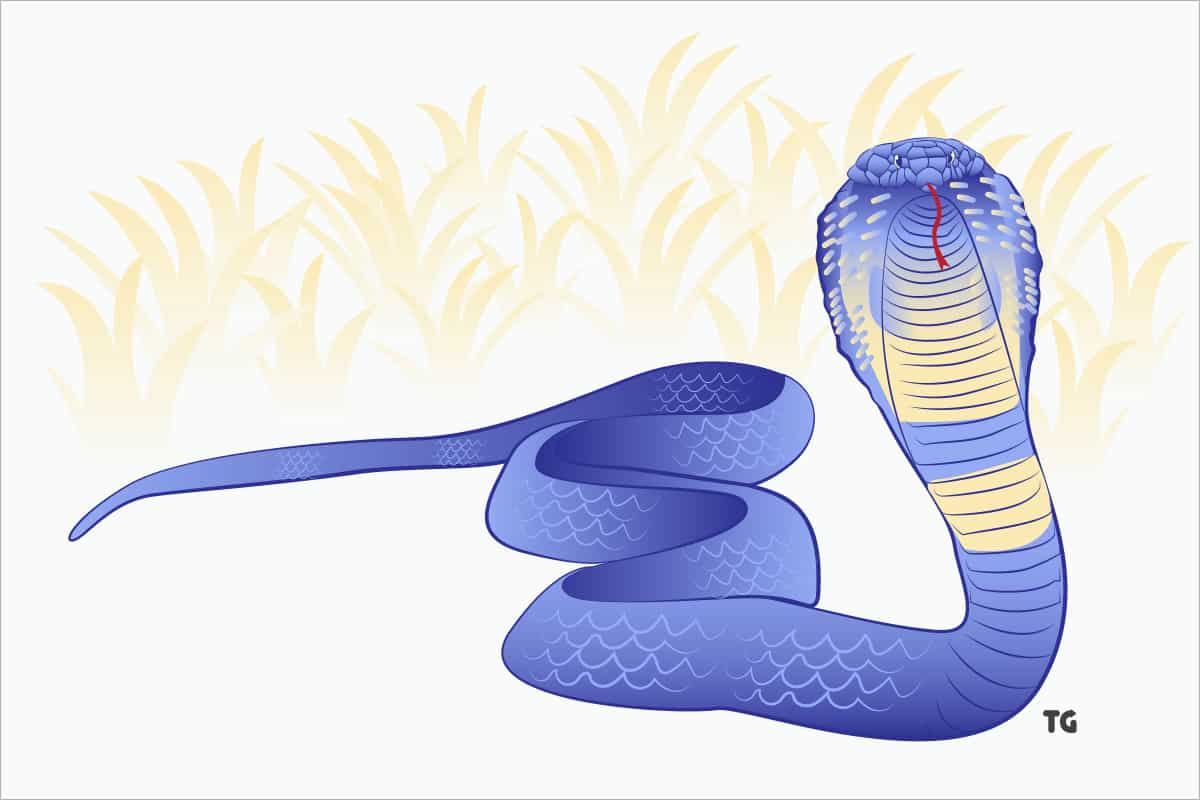Thailand is truly a world biodiversity hotspot located in a tropical climate with incredible geographical ecosystems. It is no wonder why so many wildlife and species are found. As such, Thailand can be a magnet for nature enthusiasts. However, for some people, there is a fear of unexpectedly coming into contact with such wildlife. So, is Thailand full of snakes?
With its tropical climate and terrain, Thailand is the perfect environment for many snakes as well as other reptiles and animals. There are more than 200 species of snakes living, whether they be severe venom, mild venom, or non-venomous. They can be seen everywhere, both on land and in water.
So, if you are scared of snakes, and this has given you second thoughts about visiting Thailand, read on.
This article will share some useful information about snakes in Thailand and the most common snakes you are likely to see. We’ll also answer the popular questions that people worry about and some tips guide to avoiding snakes.
So, don’t cancel your flight ticket just yet, here’s your Thailand snake survival guide. Let’s start with the basics.
Does Thailand have big snakes?
With so many species of snake in Thailand, it is natural that some are going to be of a large size. The biggest of all is the reticulated python (งูเหลือม), which is estimated to have a length range of 1.5 to 6.5 meters (or almost 10 meters). Although they are non-venomous snakes, they are considered dangerous to human beings. Especially for children or to adults while sleeping.
More interestingly, besides real snakes, it is believed that there are mythical giant snakes in Thailand known as “Naka or Naga.” (To learn more about this story, check out our Naka Cave Guide.)
11 Most Common Snakes in Thailand
| # | Snake | Official Name | Thai |
| 1 | Mangrove Snake | Boi Dendrophila | งูปล้องทอง |
| 2 | King Cobra | Ophiophagus Hannah | งูจงอาง, งูเห่าดง |
| 3 | Black and White Spitting Cobra | Naja Siamnsis | งูเห่าพ่นพิษสยาม |
| 4 | Sumatran Spitting Cobra | Naja sumatrana | งูเห่าทองพ่นพิษ |
| 5 | Reticulated Python | Malayopython reticulatus | งูเหลือม |
| 6 | Keeled Rat Snake | Ptyas carinata | งูสิงหางดำ, งูบองหมาบควาย |
| 7 | White-Bellied Rat Snake | Ptyas fusca | งูสิงทอง |
| 8 | Black-Banded Sea Snake | Laticauda laticaudata | งูสมิงทะเลปากดำ |
| 9 | Puff-faced Water Snake | Homalopsis buccata | งูหัวกระโหลก, งูเหลือมออ |
| 10 | Green Snake | Chrysopelea ornata | งูเขียวพระอินทร์, งูเขียวดอกหมาก |
| 11 | Red Snake | Bungarus flaviceps | งูสามเหลี่ยมหัวแดง |
Let’s look at these in more detail…
1. Mangrove Snakes
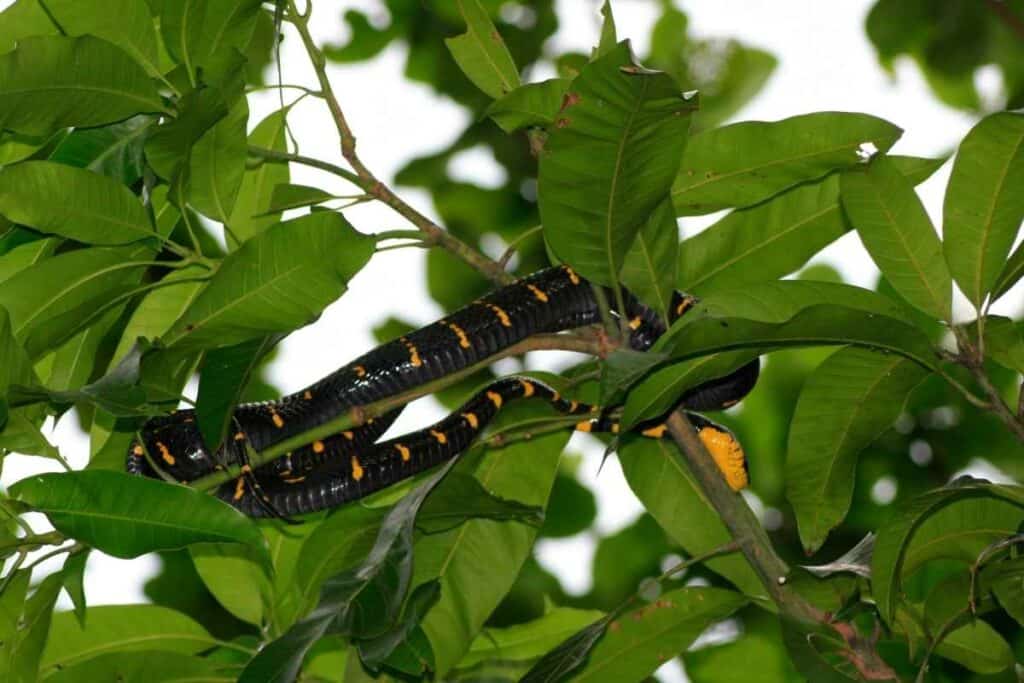
Mangrove snakes or “งูปล้องทอง (Gold-ringed cat snake)” (Scientific name: Boi Dendrophila) are medium-sized snakes of a 1.8 to 2.4-meter length.
Their distinctive feature is that they have a black head and body with a continuous small yellow ring across the black color. This is why they are known as the “Gold-ringed cat snake.” They are mildly venomous snakes that are not life-threatening to humans, however, they can cause pain and swelling. According to The International Union for Conservation of Nature (IUCN), they are a minor concern. (Source, Source)
Habitat:
The mangrove snakes are widely distributed throughout Southeast Asia. They are mostly found in Southern Thailand. Most of their habitats are humid forests and even mangrove forests with relatively high humidity. These snakes are aggressive and nervous. But are solitary and nocturnal ambush predators. They rest on the branch of a tree during the day and hunt at night.
Diet:
The mangrove snakes hunt a wide variety of prey. Reptiles (including other snakes), birds, and small mammals (such as rodents) are their main diet. While young-aged or some small-sized snakes prefer to forage frogs, lizards, and slugs.
2. King Cobras
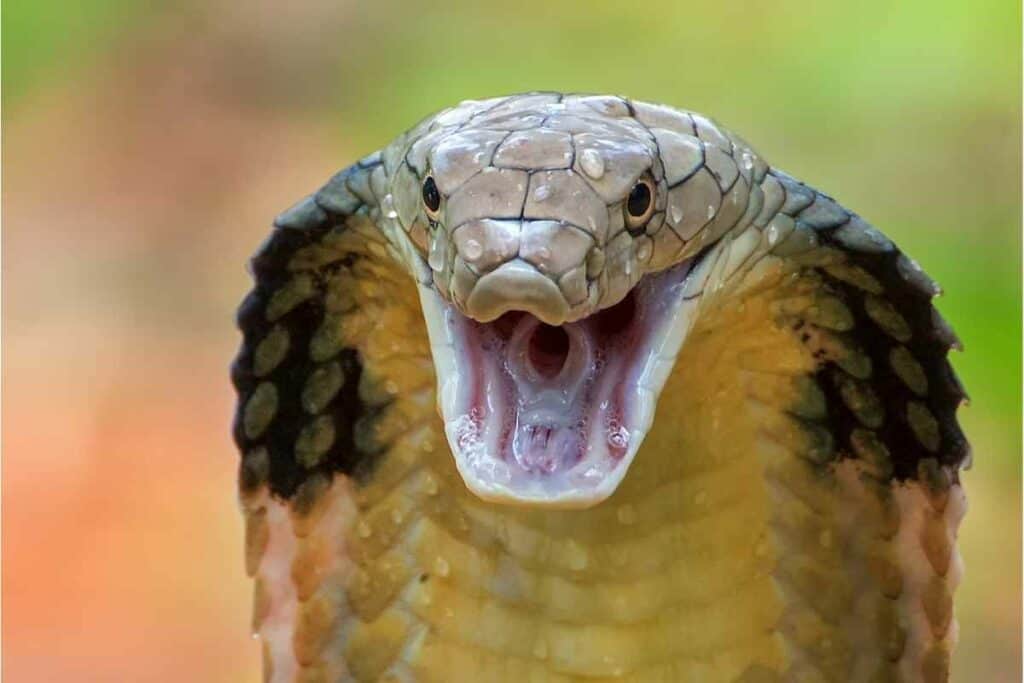
King Cobras, or “งูจงอาง, งูเห่าดง” (Scientific name: Ophiophagus Hannah), are the longest venomous snakes in the world. They can reach up to 7 meters, and live about 20 years.
Interestingly, the King Cobras are not considered the true cobra, but they are a separate genus. They are the only snakes that remain with their eggs until they hatch.
Considering their size, they actually move quite quickly. A bite from them has the power to kill a bigger Thailand animal, such as an elephant. They are considered very dangerous to humans and deadly snakes that should be avoided in Thailand at all costs. (Source, Source)
Habitat:
King Cobras can be found throughout Asia, including India, China, Malaysia, Indonesia, the Philippines, Vietnam, and of course, Thailand. They prefer to live near lakes, rivers, swamps, and streams in dense or open forests, bamboo thickets, and dense mangrove forests.
More interesting, there is such a place in Khon Kaen named “King Cobra Village,” where almost every household owns or pet King Cobra. It has the King Cobra Show consisting snake dancing and boxing between king cobra and man and also and historical exhibitions about them. (Source)
Diet:
The King Cobras primarily feed on cold-blooded animals such as other snakes (Ophiophagus), but may also eat eggs, frogs, small mammals, and reptiles. However, they rarely hunt rodents and lizards.
3. Black and White Spitting Cobras
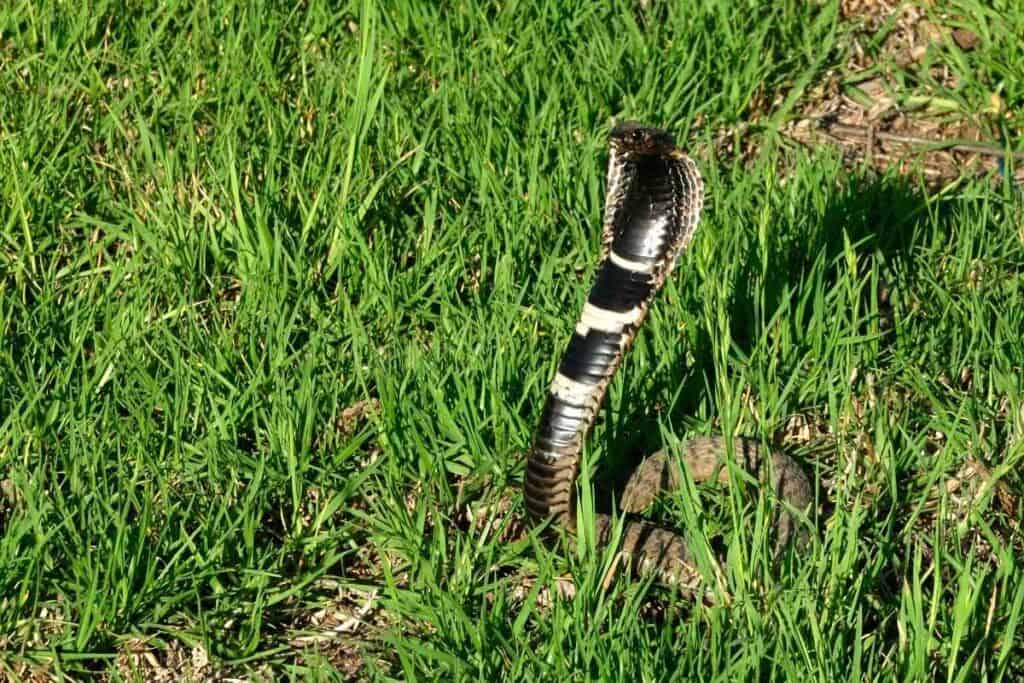
The Black and White Spitting Cobras or “งูเห่าพ่นพิษสยาม” (Scientific name: Naja Siamnsis) are also called the Thai spitting cobra.
Their distinctive feature is a black body, which is why sometimes they are referred to as black snakes. They are a medium-sized cobra, averaging 1 to 1.2 meters long. Although in rare cases, they can grow up to 1.5 meters long.
They are nocturnal; if they are spotted during the daylight, they will appear timid and make their way to the nearest burrow. However, at night, they are more aggressive, spitting venom at threats.
If this venom gets into the eyes, the pain will be immediate, and victims may experience temporary or permanent blindness. (Source)
Habitat:
The Black and White Spitting Cobras can be found throughout Southeast Asia, including Thailand, Cambodia, Vietnam, Laos, and Burma. They can live in a range of habitats such as lowlands, hills, and woodlands. They can also be found throughout jungles, and even in human settlements due to an abundance of rodents.
Diet:
They tend to feed on rodents (such as small rats), toads, other snakes, and small animals (such as birds, lizards, and fish).
4. Sumatran Spitting Cobra
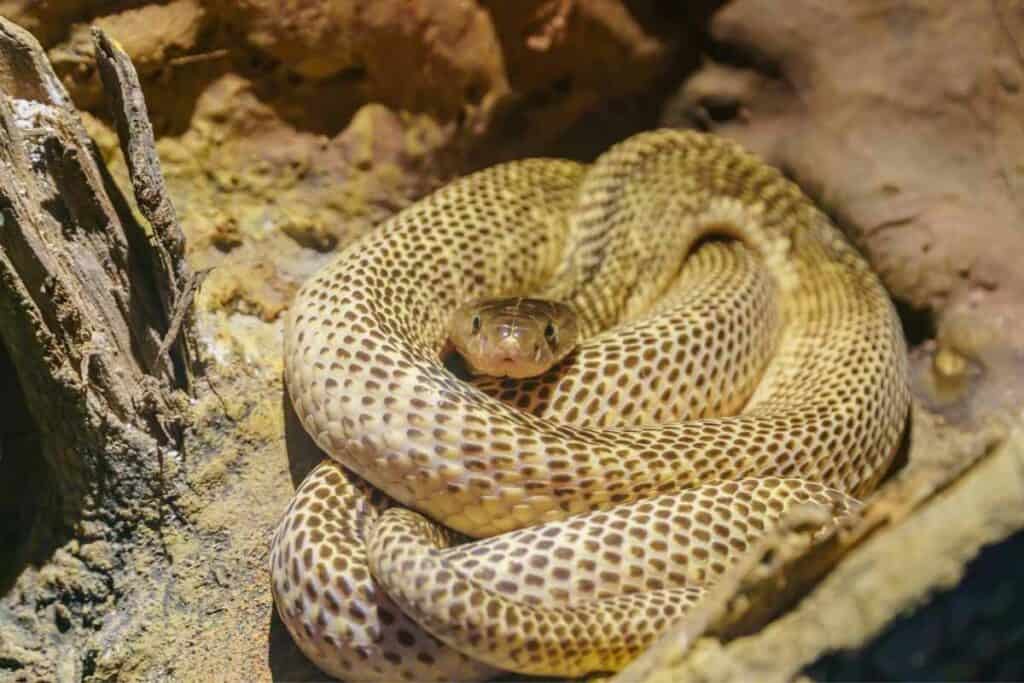
There are many Spitting Cobras (of the Naja genus) in Thailand – the Sumatran Spitting Cobra or Equatorial Spitting Cobra (งูเห่าทองพ่นพิษ), the Siamese Spitting Cobra or Thai Spitting Cobra (งูเห่า) and the Black and White Spitting Cobras (งูเห่าพ่นพิษสยาม).
The Sumatran Spitting Cobras or Equatorial Spitting Cobras or “งูเห่าทองพ่นพิษ” (Scientific name: Naja sumatrana) are a medium-sized snake. They average between 0.9 and 1.2 meters in length, although they can grow to up to 1.5 meters.
They have no hood marks and the color can vary depending on the location. For example, in Thailand, they are yellow, and in Malaysia, Singapore, Indonesia, and the Philippines, a black form is found. That is why they are also called black snakes. This is a poisonous snake in Thailand that possesses postsynaptic neurotoxic venom. (Source)
Habitat:
The Sumatran Spitting Cobras are found in equatorial Southeast Asia. They can be found at elevations of 1500 meters above sea level, and in tropical forests. They can sometimes also be found in human-populated areas, such as parks and gardens.
Diet:
Like other cobras, they are terrestrial and diurnal snakes that feed on rodents, frogs, lizards, and small mammals, as well as other snakes. Interestingly, they can control rat populations on plantations or agricultural areas.
5. Reticulated Pythons
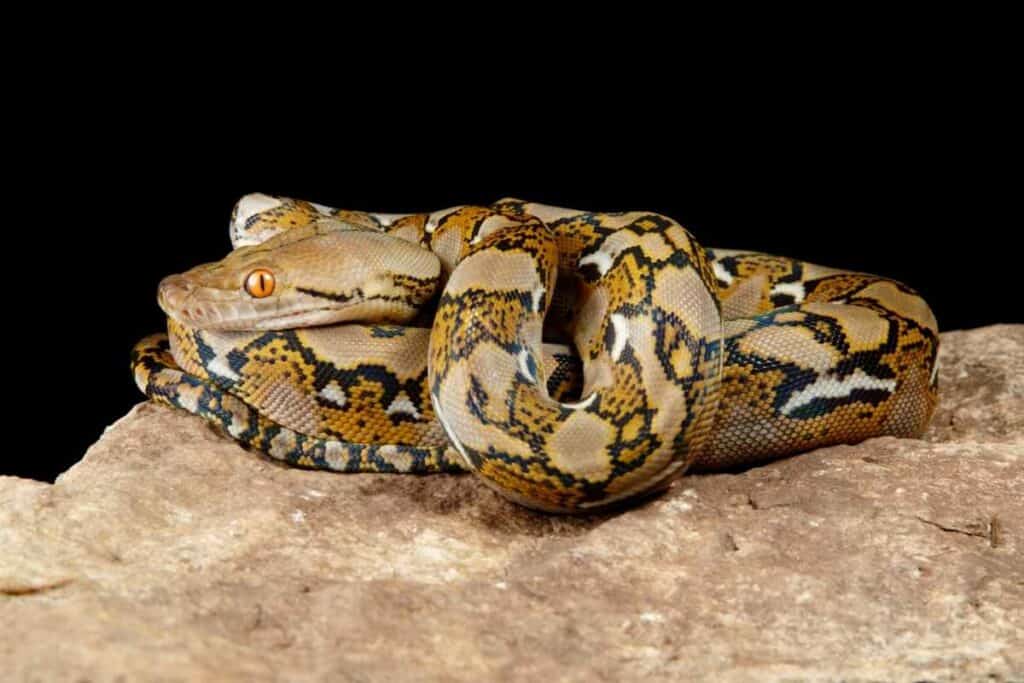
The Reticulated Pythons, or “งูเหลือม” (Scientific name: Malayopython reticulatus) are a python species native to South and Southeast Asia.
The Reticulated Pythons in Thailand are considered to be the longest and biggest species of snake in the world, estimated to have a length range of 1.5 to 6.5 meters. They are also among the three heaviest, with a weight range of 1 to 75 kilograms. They are non-venomous snakes in Thailand but they can be dangerous to humans. Besides this species, another two species of Python (family: Pythonidae) are found: Burmese Pythons (งูหลาม) and Brongersma’s Blood Python (งูหลามปากเป็ด). (Source, Source)
Habitat:
They can be found in rainforests, woodlands, and nearby grasslands. They can also be found near water and are known to be excellent swimmers.
Diet:
Reticulated pythons are ambush predators. They can wait patiently for their prey until they are within striking range. Considered one of the giant snakes in Thailand, it kills by constriction. It can consume primates, pigs, and deer. They have also been known to eat chicken, cats, and dogs when near human habitation.
6. Keeled Rat Snakes
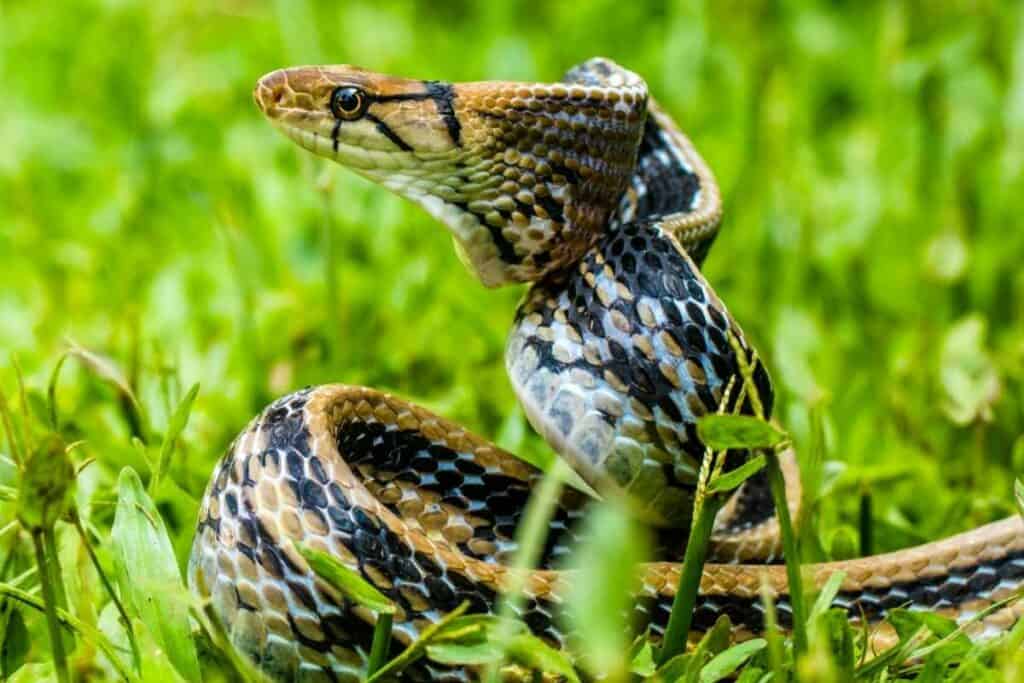
The Keeled Rat Snake or “งูสิงหางดำ, งูบองหมาบควาย” (Scientific name: Ptyas carinata) are species of colubrid snake.
They are found throughout Southeast Asia, including Indonesia, Myanmar, Malaysia, Thailand, the Philippines, Cambodia, India, Vietnam, and Singapore. Adults of the Keeled Rat Snake are measured to be 1.20 to 2.75 meters. The maximum reported size is 4 meters in length. (Source, Source)
Habitat:
Keeled Rat Snakes mostly live in lowland and hilly moist forests, dry forests, plantations, and rice fields.
Diet:
They are opportunistic predators, feeding on a variety of prey. This may include rodents, lizards, frogs, other snakes, and other small mammals.
7. White-Bellied Rat Snakes
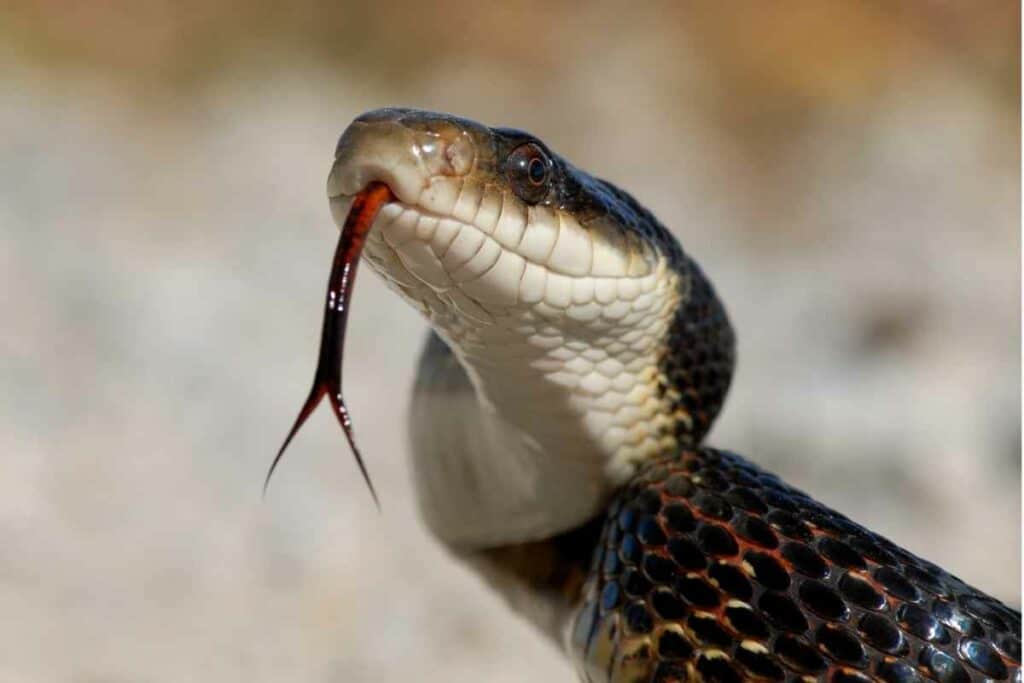
The White-Bellied Rat Snakes or Brown Rat Snake, or “งูสิงทอง” (Scientific name: Ptyas fusca), are also species of colubrid snake.
Ranging from brown to red in color, they are found in Indonesia, Brunei, Malaysia, Thailand, and Singapore.
They are well-known as hooded snakes. They remain still and hold their neck erect when disturbed, then move very fast and ready to bite – an aggressive posture. But most of the time, they will try to flee when encountered. (Source)
Habitat:
The white-bellied rat snakes can be found in forested areas to areas around water, lakes, and rivers. In the residential area, they can be found in water culverts, walking trails, or even in the garden
Diet:
The white-bellied rat snakes feed on frogs, lizards, fish, and occasionally birds.
8. Black-Banded Sea Snakes
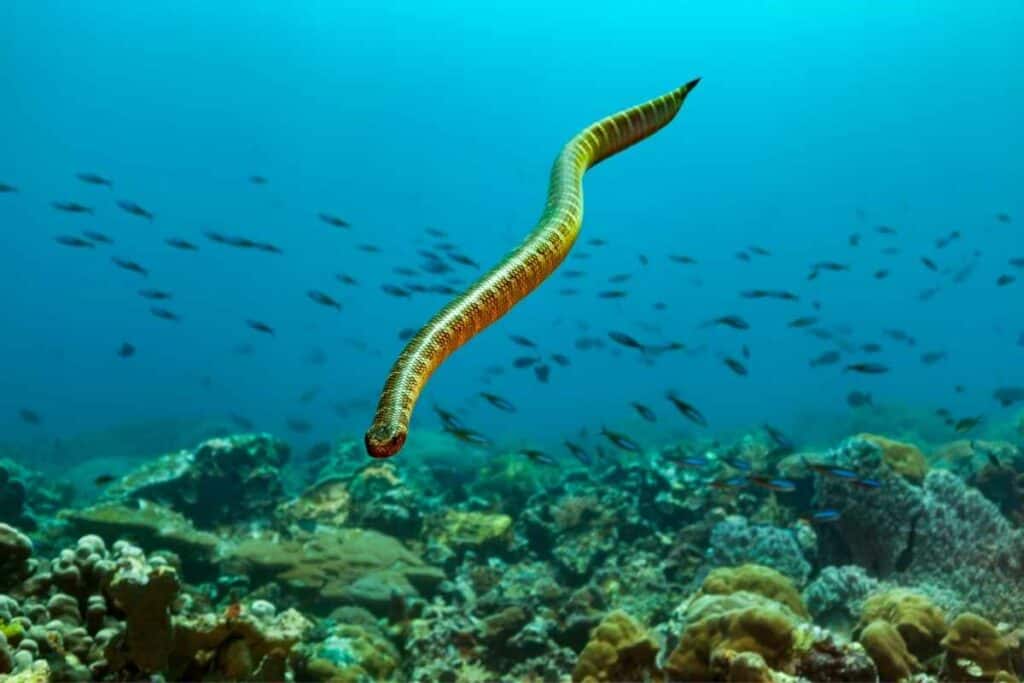
The Black-Banded Sea Snakes, or Brown-Lipped Sea snakes, or “งูสมิงทะเลปากดำ” (Scientific name: Laticauda laticaudata) are a venomous species of sea-snake found in the Indian and Pacific Oceans.
They are also commonly known as the Chinese Sea Snake or Erabu. They can reach a total length (including tail) of 1.7 meters. They have long and slender bodies, which can help them forage on the reef and corals in search of their prey. (Source)
Habitat:
This species can be found in the warm waters of the western Pacific Ocean (such as India, Myanmar, Thailand, Indonesia, Andaman Islands, coasts of Malay Peninsula, Japan, Solomon Islands, etc.).
Diet:
Being too slow to chase fish in open water, the Black-banded Sea Snake hunts for fish by hiding in coral reefs. Their main diets are eels and small fish, which they catch and paralyze with their venom before swallowing them.
9. Puff-faced Water Snakes
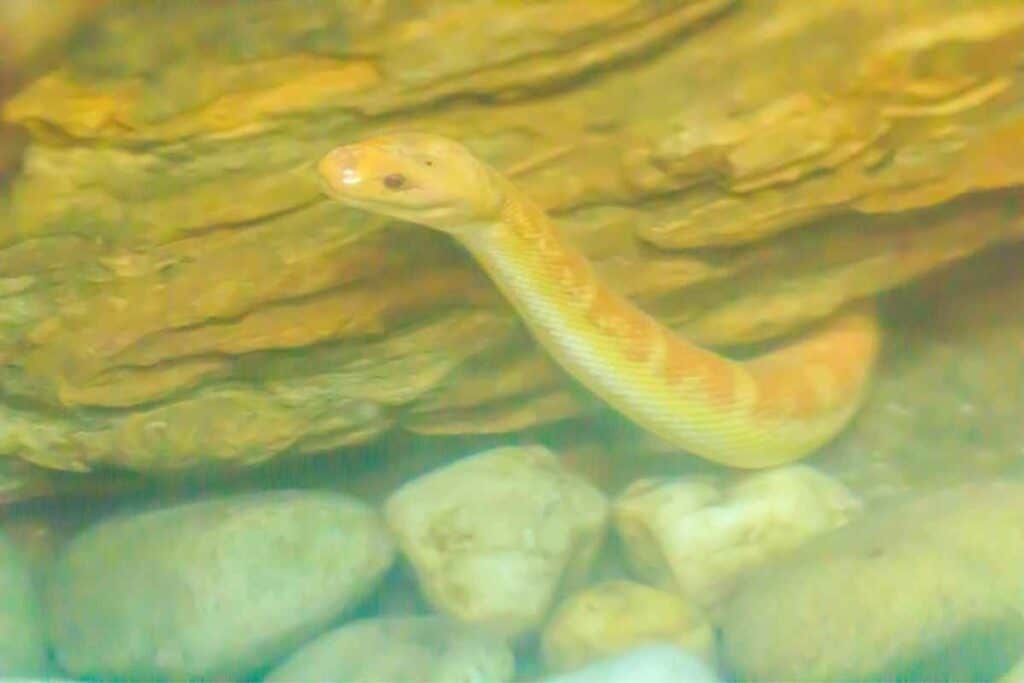
The Puff-faced Water Snake or “งูหัวกระโหลก, งูเหลือมออ” (Scientific name: Homalopsis buccata) are another species found in Asia. They have a distinctive appearance with a banded pattern and usually reach 1 meter in length. They use a mild venom from a grooved rear fang to subdue prey. (Source)
Habitat:
Puff-faced Water Snakes can be found from northern Sumatra to Salanga Island, Indonesia, and Borneo. It is present on the Malaysian peninsula and in extreme southern Thailand. In the wild, they live in various water habitats such as rivers, lakes, ponds, swamps, rice fields, and brackish water. They hide in burrows and crab holes during the day.
Diet:
They feed on tilapia, guppy, catfish, swamp eel, and various other small fish. They also eat various species of frog and freshwater crustaceans.
10. Green Snakes
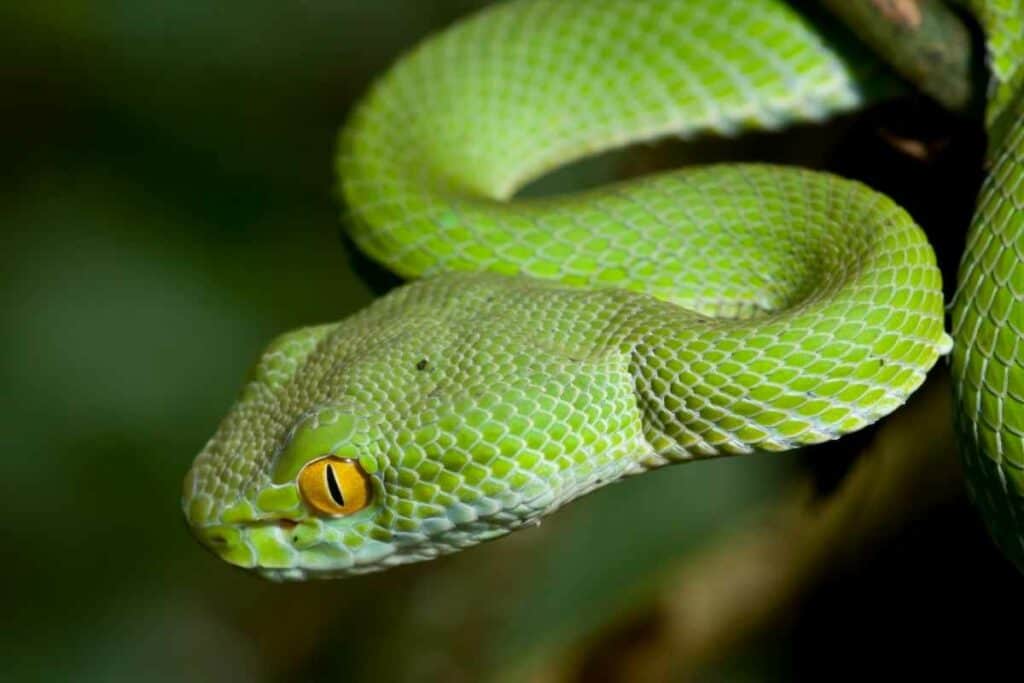
Snakes vary in colors depending on the environment they have adapted to, likewise green snakes adapting to bushes and trees.
Green Snakes or “งูเขียวพระอินทร์, งูเขียวดอกหมาก” (Scientific name: Chrysopelea ornata) ranges from 1.15 to 1.30 meters in length. They have a flattened head with a slim neck, a blunt nose, and large eyes with circular pupils.
Green snakes in Thailand are not poisionous. Many people believe that green snakes are dangerous, but in fact not all of them have venom. In Thailand, only the vipers are venomous and are not aggressive to humans. They are reluctant to attack and would rather slither away. (Source, Source)
Habitat:
They can be found in rainforests, open forest areas, grassy areas, meadows, marshes, plantations, gardens, and even in houses. Sometimes, they are found on the ground or climbing in bushes.
Diet:
The green snake feeds on small rodents, geckos, bats, bird eggs, and other lizards. They are also insectivores, including worms, crickets, moths, caterpillars, spiders, and grasshoppers.
11. Red Snakes
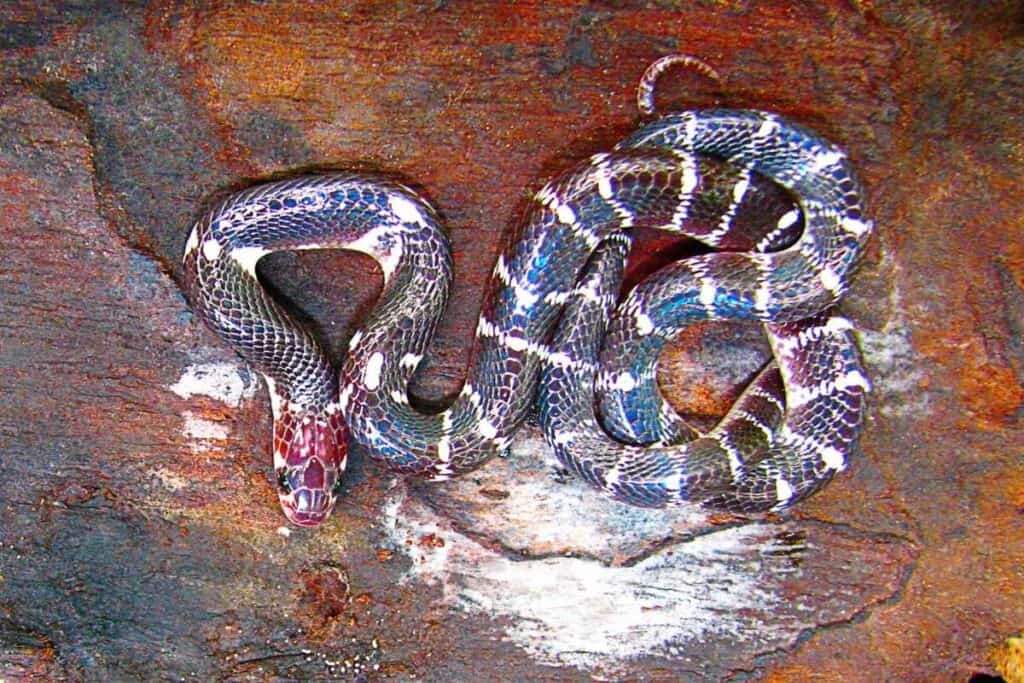
The Red Snake or “งูสามเหลี่ยมหัวแดง” (Scientific name: Bungarus flaviceps) is black or dark gray in color. As you would expect by the name, the head and tail are bright red (but can be orange).
They grow to be about 2 meters long. They are active both during the day and at night. They are not known to be aggressive. However, they are very venomous and deadly.
They are one of the most venomous snakes on the planet and are considered among the top three of the most venomous snakes in Thailand. (Source)
Habitat:
In Thailand, Red Snakes are only found in the southern Thailand provinces from Ratchaburi and Southward. They are typically found in lowlands and hilly rainforests.
Diet:
Red Snakes are carnivores and have a wide range of diets, such as frogs, toads, lizards, eggs, birds, rodents, and other snakes.
Where to Find Snakes in Thailand?
In Thailand, snakes can be found all over the country, and they live in a wide variety of habitats, such as forests, swamps, grasslands, and woodland. Most of their habitats tend to be wooded areas below 2,000 height and often near water sources, in both fresh and salt water.
However, some snakes can be seen in Thailand near residential areas, such as in basements, on wall ledges, around stored boxes and clothing piles, near water pipes, and in confined areas with dark spaces.
There are two ways if you really intend to see or study snakes in Thailand:
- Visit natural places, whether it be forests, parks, waterfalls, beaches, or even go trekking or hiking on nature trails.
- Visit the natural museums, especially the reptile and snake zone. This place is suitable for those who want to study snakes in particular.
However, if you are one who has a fear of snakes or does not want to encounter any snakes, you should avoid these places.
How Likely Are You to See a Snake in Thailand?
If you travel around a big city like Bangkok, walk around the street in a crowded town, or go shopping at the department stores in Thailand, the chance of seeing snakes is very low.
If you visit the countryside or some natural places such as mountains, waterfalls, beaches, national parks, gardens, or any fields, the chance of seeing snakes is more than being around the city. Therefore, the possibility to see snakes in Thailand depends on where you visit.
Let’s consider these places (and situations) in more detail:
Will I See Snakes in Bangkok?
The chances of encountering snakes at tourist attractions in Bangkok are very low. However, it is possible to see snakes in Bangkok’s residential areas during Thailand’s rainy season.
According to the latest statistical data, from January to July 2022, over 22,000 snakes were found in houses in areas of Bangkok. This is an average of 53 times a day (or more than twice an hour) over a 7-month period. The most common species found were pythons, cobras, and green snakes.
However, in 2021, more snakes were found in Bangkok – over 40,000, in fact. (Source, Source)
Are There Snakes in Phuket?
Phuket is a home of some species of snakes, both venomous and non-venomous, living on land and ocean. However, you’re more likely to see snakes during their breeding season (around November to January). (Source, Source)
Besides encountering wild snakes, there is an interesting place –”Phuket Cobra Show and Snake Farm,” located inside the Phuket Shooting Range. This snake farm has around 50 different types of snakes and also has the King Cobra show, which aims to entertain, educate, and provide useful information about snakes. (Source)
Does Koh Samui Have Snakes?
Koh Samui has snakes, both venomous or non-venomous. However, nothing to worry about as most of the identified snakes are not aggressive to humans (unless you offend them first).
Besides wild snakes, there is “Snake Farm Ko Samui” which is a snake and reptile zoo. Most of them are contained in cages and terrariums, which is completely safe. It also has different species of snakes presented on the show, especially the King Cobra and the Python. (Source)
Will I See Snakes in My Hotel Room in Thailand?
In general, by hotel standards, the chances of encountering snakes in Thailand hotels for tourists is very low. However, if you visit the countryside and stay in a waterfront hotel, or any hotel near the mountains, forest, within a park area, or even by the seashore, it is a possiblility.
Whatsmore, if you leave windows or doors in your hotel room open, the chances increase. It’s probably best to stick to that air conditioner at night time!
Do Snakes Come out of Toilets in Thailand?
Seeing snakes in Thailand toilets is always shocking news but there is a small chance of such events. Moreover, in fact, not only can snakes really come up a toilet pipe, but also other small animals like rats, frogs, and cockroaches. The latter is more likely to happen.
Are There Snakes in Thailand’s Rivers?
There are more than 25 species of water snakes in Thailand that live in rivers, water, swamps, marshes, or any humidity places. The most common water snakes seen in Thailand are the Puff-faced Water Snakes, Crab-Eating Water Snake, Glossy Marsh Snake, Yellow-Bellied Water Snake, Rainbow Water Snake, Mekong Mud Snake, and Martaban Water Snake, to name a few. (Source)
How to Avoid Snakes in Thailand?
As tourists, the best way to avoid snakes is to understand their nature and all sort of places they live in.
Keep in mind these easy ways to protect yourself from snakes in Thailand: (Source)
1. Don’t pose a threat to them
Most snakes would rather avoid a human than encounter humans unless they feel insecure. Therefore, it would be better to avoid threatening or fooling around them.
2. Be aware of your surroundings
Most snakes prefer to hide or camouflage themselves, such as under rocks, under wood piles, in trees, in the shrubbery, and inside hollow logs. Therefore, do not overlook leaf litter, sticks, and plant piles when walking among the thick vegetation.
3. Learn about their behaviors
All sort of snakes has similar behaviors when it comes to fighting or protecting themselves. Therefore, it would be beneficial to learn more about, whether it be their threatening posture or how they attack to stay safe. Know this will help you understand how to react and reduce the risk of being harmed by them.
Here is a simple yet reassuring video by the Wildlife Center of Virigina on what to do if you see a snake:
Are There Venomous (Poisonous) Snakes in Thailand?
Thailand is home to more than 200 species of snakes, half of which have been identified as venomous snakes. The neurotoxic snakes can be classified into four genera: Naja (cobra snakes), Bungarus (krait snakes), Ophiophagus (king cobra snakes), and Calliophis (sea snakes). While the tissue and hemotoxic snakes belong to the family Viperidae: Crotalinae (green snakes) and Viperinae (viper snakes). (Source)
Are Snake Bites Common in Thailand?
Fortunately, the risks of being experienced or attacked by any snakes are quite low. According to the Bureau of Epidemiology, the average number of snakebites from venomous snakes within the last 10 is 7,723 cases per year, and this likely to decline every year.
Whatsmore, the chances of being bitten by a snake that is venemous enough to pose a threat to humans is really low. Therefore as a tourist or ex-pat living in Thailand, you should be cautious but not concerned.
However, the chance is quite high for Thai farmers. This can cause serious morbidity but very low mortality because competent treatment is widely available throughout Thailand. There are also vaccines that are effective enough for patients. (Source, Source)
What Is the Deadliest Snake in Thailand?
In spite of abundance of venomous snakes in Thailand, only seven of them are listed as the deadliest snakes: Black and White Spitting Cobras, King Cobras, Banded Krait, Malayan Krait, Russell’s Viper, Malayan Pit viper, and White-lipped Pit Viper. Some of them are rarely seen, while some are worryingly common, especially King Cobras.
Conclusion
Thailand is home to many species of snakes, both venomous and non-venomous. However, you have nothing to worry about as most of the common snakes are not aggressive and threaten humans (unless you offend them first).
Moreover, according to statistics, even the rate of death from being bitten by poisonous snakes is extremely low because efficient treatment is widespread throughout Thailand. More importantly, for a safe and smooth trip, it would be better to learn more about how to protect yourself from snakes!
If you encounter a snake, you can call 199 or 1677 for emergency services. Or in the unlikely event that you are bitten by a snake, you can call for health emergency at 1669, which is the general hotline in Thailand.
Like always, if you want to discover more about Thailand, stay guided with ThaiGuider. You might learn something you never knew about this unique country.
▸ Scared of creepy crawlies too? Check out our articles on “Does Thailand Have Lots of Spiders?” and “Thailand Black Tarantula Guide.”
THINKING ABOUT A TRIP TO THAILAND?
I am working on a FREE Thailand Travel Guide with a FULL 7 Day Itinerary. Be the first to receive it!
Thank you for signing up.
Something went wrong.
